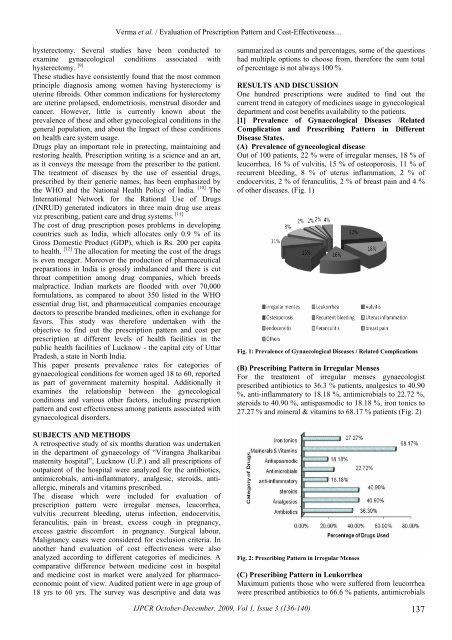Create successful ePaper yourself
Turn your PDF publications into a flip-book with our unique Google optimized e-Paper software.
Verma et al. / Evaluation of Prescription Pattern and Cost-Effectiveness....<br />
hysterectomy. Several studies have been conducted to<br />
examine gynaecological conditions associated with<br />
hysterectomy. [9]<br />
These studies have consistently found that the most <strong>com</strong>mon<br />
principle diagnosis among women having hysterectomy is<br />
uterine fibroids. Other <strong>com</strong>mon indications for hysterectomy<br />
are uterine prolapsed, endometriosis, menstrual disorder and<br />
cancer. However, little is currently known about the<br />
prevalence of these and other gynecological conditions in the<br />
general population, and about the Impact of these conditions<br />
on health care system usage.<br />
Drugs play an important role in protecting, maintaining and<br />
restoring health. Prescription writing is a science and an art,<br />
as it conveys the message from the prescriber to the patient.<br />
The treatment of diseases by the use of essential drugs,<br />
prescribed by their generic names, has been emphasized by<br />
the WHO and the National Health Policy of India. [10] The<br />
International Network for the Rational Use of Drugs<br />
(INRUD) generated indicators in three main drug use areas<br />
viz prescribing, patient care and drug systems. [11]<br />
The cost of drug prescription poses problems in developing<br />
countries such as India, which allocates only 0.9 % of its<br />
Gross Domestic Product (GDP), which is Rs. 200 per capita<br />
to health. [12] The allocation for meeting the cost of the drugs<br />
is even meager. Moreover the production of pharmaceutical<br />
preparations in India is grossly imbalanced and there is cut<br />
throat <strong>com</strong>petition among drug <strong>com</strong>panies, which breeds<br />
malpractice. Indian markets are flooded with over 70,000<br />
formulations, as <strong>com</strong>pared to about 350 listed in the WHO<br />
essential drug list, and pharmaceutical <strong>com</strong>panies encourage<br />
doctors to prescribe branded medicines, often in exchange for<br />
favors. This study was therefore undertaken with the<br />
objective to find out the prescription pattern and cost per<br />
prescription at different levels of health facilities in the<br />
public health facilities of Lucknow - the capital city of Uttar<br />
Pradesh, a state in North India.<br />
This paper presents prevalence rates for categories of<br />
gynaecological conditions for women aged 18 to 60, reported<br />
as part of government maternity hospital. Additionally it<br />
examines the relationship between the gynecological<br />
conditions and various other factors, including prescription<br />
pattern and cost effectiveness among patients associated with<br />
gynaecological disorders.<br />
SUBJECTS AND METHODS<br />
A retrospective study of six months duration was undertaken<br />
in the department of gynaecology of “Virangna Jhalkaribai<br />
maternity hospital”, Lucknow (U.P.) and all prescriptions of<br />
outpatient of the hospital were analyzed for the antibiotics,<br />
antimicrobials, anti-inflammatory, analgesic, steroids, antiallergic,<br />
minerals and vitamins prescribed.<br />
The disease which were included for evaluation of<br />
prescription pattern were irregular menses, leucorrhea,<br />
vulvitis ,recurrent bleeding, uterus infection, endocervitis,<br />
feranculitis, pain in breast, excess cough in pregnancy,<br />
excess gastric dis<strong>com</strong>fort in pregnancy. Surgical labour,<br />
Malignancy cases were considered for exclusion criteria. In<br />
another hand evaluation of cost effectiveness were also<br />
analyzed according to different categories of medicines. A<br />
<strong>com</strong>parative difference between medicine cost in hospital<br />
and medicine cost in market were analyzed for pharmacoeconomic<br />
point of view. Audited patient were in age group of<br />
18 yrs to 60 yrs. The survey was descriptive and data was<br />
summarized as counts and percentages, some of the questions<br />
had multiple options to choose from, therefore the sum total<br />
of percentage is not always 100 %.<br />
RESULTS AND DISCUSSION<br />
One hundred prescriptions were audited to find out the<br />
current trend in category of medicines usage in gynecological<br />
department and cost benefits availability to the patients.<br />
[1] Prevalence of Gynaecological Diseases /Related<br />
Complication and Prescribing Pattern in Different<br />
Disease States.<br />
(A) Prevalence of gynecological disease<br />
Out of 100 patients, 22 % were of irregular menses, 18 % of<br />
leucorrhea, 16 % of vulvitis, 15 % of osteoporosis, 11 % of<br />
recurrent bleeding, 8 % of uterus inflammation, 2 % of<br />
endocervitis, 2 % of feranculitis, 2 % of breast pain and 4 %<br />
of other diseases. (Fig. 1)<br />
Fig. 1: Prevalence of Gynaecological Diseases / Related Complications<br />
(B) Prescribing Pattern in Irregular Menses<br />
For the treatment of irregular menses gynaecologist<br />
prescribed antibiotics to 36.3 % patients, analgesics to 40.90<br />
%, anti-inflammatory to 18.18 %, antimicrobials to 22.72 %,<br />
steroids to 40.90 %, antispasmodic to 18.18 %, iron tonics to<br />
27.27 % and mineral & vitamins to 68.17 % patients (Fig. 2)<br />
Fig. 2: Prescribing Pattern in Irregular Menses<br />
(C) Prescribing Pattern in Leukorrhea<br />
Maximum patients those who were suffered from leucorrhea<br />
were prescribed antibiotics to 66.6 % patients, antimicrobials<br />
IJPCR October-December, 2009, Vol 1, Issue 3 (136-140) 137


